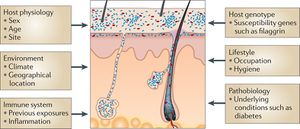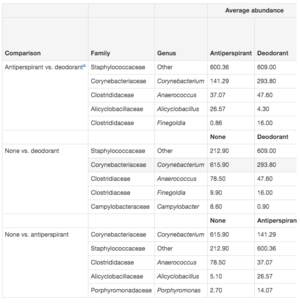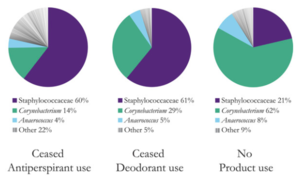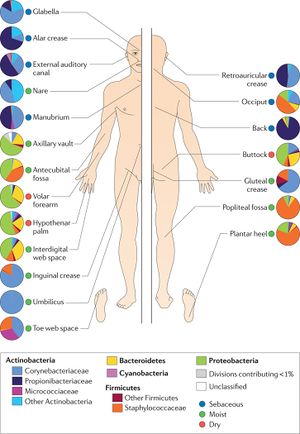User:Andreagomez-patron2020
Microbial Ecology Earth 373 MicrobeWiki Page: THE ARMPIT!
Overview
By [Andie Gomez-Patron]
Legend/credit: Electron micrograph of the Ebola Zaire virus. This was the first photo ever taken of the virus, on 10/13/1976. By Dr. F.A. Murphy, now at U.C. Davis, then at the CDC. Every image requires a link to the source.
Introduce environment. Give key information relevant to the microbial ecology of the environment.
A citation code consists of a hyperlinked reference within "ref" begin and end codes.
To repeat the citation for other statements, the reference needs to have a names: "Cite error: Closing </ref> missing for <ref> tag
This environment is easily accessed and incredibly common, making it a perfect region to be studied. The human skin environmental ecology has been studied at great lengths, in the past and currently by microbiologists and dermatologists alike. [13] This research is ongoing and has no shortage of studies focusing on armpit microbial communities. Currently, one study is focusing on understanding how deodorant affects the microbial diversity in armpit populations, however, they have cultured many different found microbes and analyzed. This is showing how chemical changes to the environment can affect the microbial ecology in this region. To the right we see an image of some of the cultures being studied within this environment. [4]
Moreover, we can see general skin environmental analysis research being done. In the image to the right we see how the general skin environment invites different microorganisms. [9]
Overview of Microbial Ecology as it is known

There is a large symbiosis and many commensals as well [13] between human skin and the microbes that inhabit it’s areas. Various parts of the skin house different kinds of microorganisms. On the surface of the skin we see mites inhabiting as well as bacteria and fungi, around the sweat glands we see the capability for virus housing, and around the hair follicles and entryways we see potential for viruses and prevalent fungi. [9]
However, different areas of the human body are more suited for different microbial communities and interact with each other differently. The armpits in particular, have one notable behavior that sets it aside from just any area of the body: sweat! Microbes within the armpit use “the organic sweat gland secretions as food, and as they break down these molecules, volatile odor compounds are released” [6].
In terms of alpha and beta diversity within this armpit system, we see the alpha diversity as incredibly diverse ranging from fungi, to mites, to bacteria, to viruses, not including the specifics of each that can arise. Therefore, we see an incredible richness of species diversity. In terms of beta diversity, we see that the community abundances can change greatly depending on the different conditions of the armpit such as hygiene, moisture content, odor represents, and more. [4]
For this change in diversity abundances depending on different conditions, we look to the image on the right. [9]
Expansion topic 1: Implications to Disease/Rashes
Various diseases, infections, and rashes can occur due to the microbes living under our arms. Some of the more prevalent and scary bacterial infections that can occur in the armpits are furuncle, also known as boils. [14] We could also see Erythrasma, which is caused by Corynebacterium minutissimum, a type of bacteria. This presents itself as lesions and scales of various irritated colors. [14]
Moreover, scabies is an infection that can occur in various parts of the human body including the armpits. This forms from mites that live on the skin, specifically scabies mites, which cause a reaction since the skin is not used to the feces and proteins of the scabies mite.
Finally, we can also see fungal infections in the armpit region. One example is ringworm, which is caused by a “family of dermatophyte fungi such as Trichophyton, Microsporum, and Epidermophyton.” [10], and more specifically, Trichophyton rubrum. [15]
Expansion topic 2: Implications to Smell!


One recent study did a test comparing deodorant user armpits versus all natural armpits and found that those that do not use any kind of oder preventing substance such as antiperspirants or deodorants, have most prevalent Corynebacterium while “individuals who used antiperspirants or deodorants long-term, but who stopped using product for two or more days as part of this study, had armpit communities dominated by Staphylococcaceae.” [4]. The presence of Staphylococcus hominis [5] is one of the leading and dominant factors contributing to this particular region’s pungent smell!
Key Microbial Players

The skin has an incredible array of different microorganisms at play all over the body. Some of the most important microbial players across skin are Staphylococcus, Micrococcus, Corynebacterium, Brevibacterium, Dermabacter, and Malasezzia. [13]
When looking at the microbes in the human armpit, it is important to understand that each area of the human body provides slightly different moistures, exposure to light, pH levels, gland secretion, and other environmental factors. Therefore, while there will be some underlying similarities in some of the communities on the body, that armpit will have its own very specific key microbes. From the image below [9], we can see that for the armpit (labeled “Axillary Vault”) in particular, we see a large majority of proteobacteria, and a smaller yet still important collection of bacteroidetes.
What is incredible is that within the armpit we find microorganisms that fall into categories all over the tree of life ranging from fungi, to bacteria, to viruses, and to incredibly insects!
Many studies and research over the years have made cultures of these microbes to study them and their roles in this specific region. In summation, we see that arguably, the most important microbial player, Staphylococcus, causes BO!
Conclusion
References
Authored for Earth 373 Microbial Ecology, taught by Magdalena Osburn, 2020, NU Earth Page.
